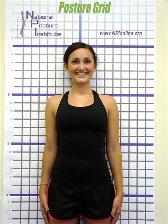august 2012
FAQs About Posture
Posture is an important consideration in all activities of daily living (e.g., walking, lifting objects and driving). Keeping good posture can make a difference to the long-term health of your spine. Many postural problems are detectable at early stages, regardless of age. If not corrected, these issues will become more pronounced.
1. What is posture?
Posture is a state of skeletal and muscular balance and alignment that protects the supporting structures of your body from progressive deformity and injury (Britnell et al. 2005). Whether you are erect, lying, squatting or stooping, good posture allows your muscles to function with maximum efficiency. With good standing posture your body’s joints are in a state of equilibrium with the least amount of physical energy being used to maintain this upright position (Kritz & Cronin 2008).
2. What is a posture muscle?
Posture muscles help to fix or stabilize a joint; they prevent movement, while other muscles create movement. They are composed of muscle fibers that have a particular capacity for prolonged work. For instance, as you lean forward slightly to walk up stairs (the movement), the posture muscles surrounding the spine help to prevent the upper body from falling too far forward.
3. Does poor posture affect a person’s psychological health?
Yes. People with poor posture are more likely to have poor self-image and less self-confidence (Watson & MacDonncha 2000).
4. What are the natural curves in a healthy spine?
The low back (lumbar spine) curves inward (toward the anterior part of the body) and is called the lordotic curve. The middle back (thoracic spine) is curved outward (posterior to the body). The neck (cervical spine) curves slightly forward or inward and thus has a lordotic curve.
5. What is “neutral spine”?
Although the vertebral column has three natural curves, “neutral spine” usually refers to the lumbar region. Neutral spine is a pain-free position of the lumbar spine attained when the pressures in and around the pelvis joint structures are evenly distributed. The pelvis is balanced between its anterior and posterior positions.
6. What are neuromuscular control exercises for the spine?
Exercise programs that are designed for musculoskeletal injury prevention involve neuromuscular control components (Akuthota & Nadler 2004). These programs involve joint stability exercises, balance training, proprioceptive training, plyometric exercises and skill-specific training. They provide multiple stimuli to improve the body’s neuromuscular control mechanisms.
7. Is poor posture associated with increased falls in older adults?
Yes. A study found that the best predictor of future fall risk in people aged 62–96 was deficiency in lateral posture stability (Maki, Holliday & Topper 1994). Lateral stability exercises can help older adults prevent falls.
Make A Difference-Improving Your Client’s Posture
Do you want to enhance your client’s/patient’s posture? A National Posture Institute-Certified Posture Specialist™ (CPS™) can help. Qualified NPI-Certified Posture Specialists assess their clients’ postural patterns and target abnormal patterns such as lordosis (abnormal inward or forward curvature of the vertebral column) and kyphosis (abnormal curvature of the spine, causing a hunchback). A postural assessment provides an objective means of identifying postural concerns and establishing a direction for appropriate exercise program design. To learn more, contact Ken Baldwin, Assistant Professor and Executive Director of NPI at ken@npionline.org for more information on becoming a CPS.
References
Akuthota, V., & Nadler, S.F. 2004. Core strengthening. Archives of Physical Medicine and Rehabilitation, 85 (3) (Supp. 1), S86–92.
Britnell, S.J., et al. 2005. Postural health in women: The role of physiotherapy. Journal of Obstetrics and Gynaecology Canada, 27 (5), 493–500.
Kritz, M.F., & Cronin, J. 2008. Static posture assessment screen of athletes: Benefits and considerations. Strength and Conditioning Journal, 30 (5), 18–27.
Maki, B.E., Holliday, P.J., & Topper, A.K. 1994. A prospective study of postural balance and risk of falling in an ambulatory and independent elderly population. Journal of Gerontology, 49 (2), M72–84.
Watson, A.W.S., & MacDonncha, C. 2000. A reliable technique for the assessment of posture: Assessment criteria for aspects of posture. The Journal of Sports Medicine and Physical Fitness, 40 (3), 260-70.
This article has been reprinted with permission from the copyright owner, IDEA Health & Fitness Inc (www.ideafit.com). Reproduction without permission is strictly prohibited. IDEA Fitness Journal, Volume 8, Number 7 - July 2011
If you are interested in purchasing NPI's Posture Grid, CLICK HERE.
|
